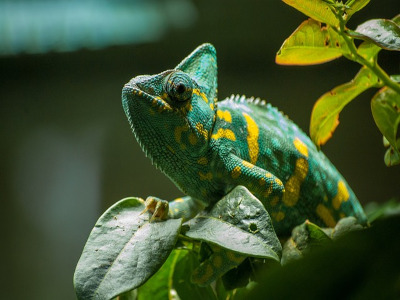The chameleon, whose scientific name is chamaeleonidae, belongs to the type of reptiles and is a carnivore (if an animal is a carnivore, it means that its diet consists of meat or flesh). It usually reaches a life span of up to 12 years when it lives in the wild. Also, it can reach a size of about 50 cm and a weight of about 400 grams. Their habitat is in the rain forest and in Africa’s deserts. The chameleons that live in the desert are normally brown, and the ones in the trees of the rain forest tend to have a green color. There are over 200 species of chameleons.

1) The ability to change colors
The most common fact about chameleons is that they are able to change colors. They do so in order to cool down or warm up since dark colors absorb the heat better, and they get warm through that. Also, changing their color has a communication purpose. When they change colors to a brighter shade, they intend to get the attention of potential mates or scare off enemies. But how are they even able to change the color of their skin?
Their skin consists of multiple layers. While the skin layer on the surface is see-through, the layers underneath have special pigment-filled cells. This pigment is responsible for giving plants, animals, and, of course, humans their color. In order to change the color of the chameleon’s skin, the brain conveys a message to these cells, and then they get bigger or smaller. During this process, pigments from several cells get combined, and a new skin color is created. An example of this process is that a blue skin color results from the mix of blue and red pigments.
2) Unique vision
The panoramic vision of chameleons is a unique feature that makes them very famous. Their eyelids are shaped like a cone, and their pupils are very small and round. A feature that is not possible for most of the animals is that they can rotate and move their eyes quite independently, and they can focus on two different things at the same time.
3) Fast muscle movement in the tongue
When chameleons see their prey, for instance, an insect, then they roll out their tongue at such a high speed that the insect most likely will not have a chance because it is not able to escape since the sticky tongue captures it. Research found that the chameleon’s tongue, if it were a car, could accelerate from 0 to 97 km/h in only 1/100th of a second. Also, the tongue of a chameleon is twice its body length.
4) Toes and tails as navigation systems
To get around, chameleons use their toes and their tails to grab and hold onto objects like sticks and branches. A characteristic of most lizards is that they have five toes. Also, the chameleon has them, but the spacing is different. The combination of the toes in the front feet and on the back feet is opposite.
Chameleons can use their tail, similar to their toes, to hold onto things. When they have an injury on their tail, they cannot regrow it like other lizard species can.
5) Some chameleons are endangered
The IUCN (International Union for Conservation of Nature) created a list that shows the extinction risk of every animal. Since there are so many chameleon species, there are also different extinction statuses for each species. Endangered species include, for example, the Calumma tarzan or the bizarre-nosed chameleon that can be found in Madagascar. Reasons they are endangered and have to face the risk of extinction are mining and the use of land for agriculture.
Luckily, there are also species that have a low risk of extinction, like the Meditarranean chameleon or the veiled chameleon. Their habitat is safe, and their population is not decreasing but is stable.
Sources:
https://kids.nationalgeographic.com/animals/reptiles/facts/chameleon
https://www.treehugger.com/chameleon-facts-5074869
https://education.nationalgeographic.org/resource/carnivore
https://iucn.org/
